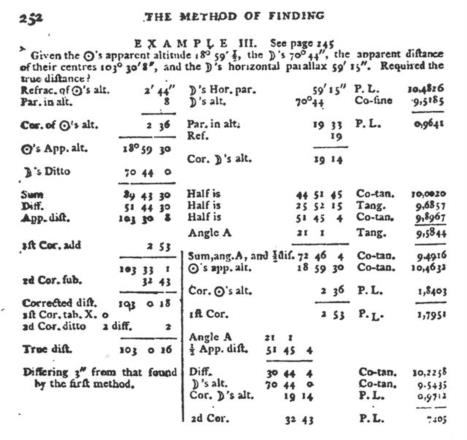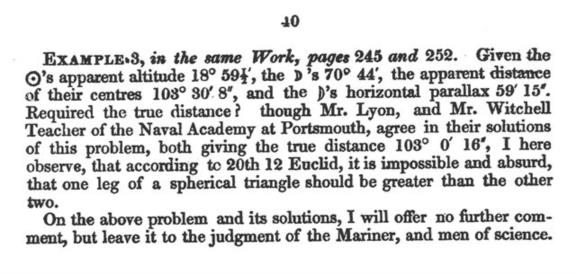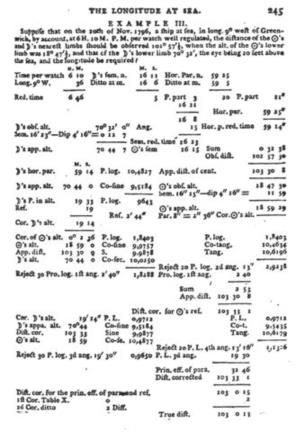
NavList:
A Community Devoted to the Preservation and Practice of Celestial Navigation and Other Methods of Traditional Wayfinding
Impossible lunar example. was: Short-cut lunars. was: Clearing lunars
From: George Huxtable
Date: 2010 Aug 28, 11:42 +0100
From: George Huxtable
Date: 2010 Aug 28, 11:42 +0100
Antoine asked- "And Last note, could one of you please publish the original data of your earlier quoted "impossible Lunar"." With pleasure, Antoine, as far back as I can.. The information was in the attachments to my posting of 25 August, threadname "clearing lunars", and here it is again. Sorry that one of the pages is pretty fuzzy, but I think it can just about be deciphered. The Janet Taylor text is from her "Luni-solar and horary tables", of 1833, fully available on Google Books. About this, I wrote- | Looking through some | examples of her method for clearing lunar distances, she has in some cases | compared her results with those given, for a similar problem, by John | Hamilton Moore, in his "Practical Navigator". My eye fell on her "Example | 3" on page 40, about which her words are attached, as "Taylor Luni-solar | p40". | | Those words intrigued me. They refer, as stated on another page, to Moore's | 10th ed. I took a look at what Moore said. His "Practical Navigator", too, | is available on Google, in his 11th ed. of 1795, and I attach the relevant | passages (using Lyons' and Witchell's methods), from pages 245 and 252. | | And indeed, Janet Taylor has got it absolutely correct. Moore has set | himself a quite impossible example. With the altitudes that he has given | for the two bodies, there isn't nearly enough spacing across the sky, in | any possible geometry, to achieve such a large value of lunar distance. | It's a contrived example, that can't possibly happen in real life. Yet he | has gone blindly through the motions of making the corrections to clear | that absurd value, by two different methods, and indeed, got the same | result in each case. | | Much of the impact of Taylor's point, made in 1833, is however lost, | because that mistake occurred some 38 years earlier. By the time Moore's | 18th edition of 1810 (also on Google) had appeared, that erroneous example | had been dropped. Since then, Frank has pointed out that the same impossible problem was presented, earlier still, by Maskelyne, in his "Tables Requisite" of 1780, but that edition isn't scanned on Google. Unlike other editions, which are, but omit that problem. So I can't quote Maskelyne's original version. Perhaps Frank has a copy. George. contact George Huxtable, at george@hux.me.uk or at +44 1865 820222 (from UK, 01865 820222) or at 1 Sandy Lane, Southmoor, Abingdon, Oxon OX13 5HX, UK.









